Paint Sprayer Review updated in 2022. As a painter for well over 30 years, I’ve applied tons of paint: literally. Here I review very good paint sprayers I am sure will save you time and cut through frustration.
First, I review the best paint sprayer on the market for homeowners and one that pros (who do not spray every day) also use.
I have also reviewed contractor quality machines: Commercial Paint Sprayers are here. One of these babbies is what most of us pros own.
I’ve used all the sprayers you see here. All my types, tips, articles, etc., are here all in one place.
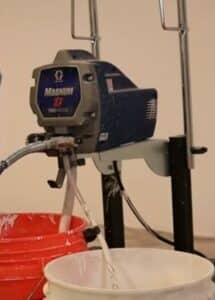
Are paint sprayers worth it?
Paint sprayers are really worth it for big jobs, and they will save you time on any paint job. I have used a range of quality paint sprayers that use air compressors (a.k.a. electric paint sprayers), as well as every kind of airless paint sprayer. The best airless paint sprayer simply pumps liquids. I compared renting vs. buying a sprayer here.
Best paint sprayer for 3 budgets. (Details below.)
1. Lowest Budget: There are really two separate worlds of paint sprayers: airless and air. The lowest budget model is an electric paint sprayer (mixes paint and air), I have to recommend the Wagner Flexio 590, check the price here. It is a very good quality paint sprayer gun for the money: the most quality for the least cost, thus the best price paint sprayer. Read my full review below.
2. Medium Budget: The best airless paint sprayer simply pumps liquids, not air. The Graco Magnum is the winner: see this powerful machine. For a medium budget, it is a high-quality airless sprayer. Taken care of, this excellent paint sprayer will last a lifetime. Read my review below.
3. Top Pick Sprayer: The Graco Magnum X7, check price online. This is my baby. Many pros use this. More below.
If you want a professional machine for (quite a bit) more money, buy my machine, the 490 PC Pro.
Is an airless paint sprayer better? With an airless sprayer, you get a better finish and faster results (higher flow rate) compared to an electric paint sprayer, but you will pay more. A big plus—no brush marks are left on the painted surface when you use an airless paint sprayer. If you spend this kind of money, be sure to use one of the most recommended paint sprayers, as using a quality sprayer will live longer, and the results will be much better.
All of my recommended paint sprayers are truly quality sprayers and will live longer than the off-brand sprayers.
Good sprayer companies
- First, the Titan (company website) has a selection of airless sprayers. They are a good, but small company, so parts can be hard to find. I don’t recommend them.
- Go with Graco (company website) because of their great reputation, very well earned. Graco replacement parts are much easier to find. Most pros use Graco.
Honorable mention for small project sprayers is Wagner (company website). They’ve been around forever, but they never cracked the professional market. Still, you can count on them if you have a lot of paint you want to spray.
All of what you find below will be fine as a latex paint sprayer or for oils, which is rare these days. These are all fine paint guns.
There are more than airless these days. Read about all types of sprayers.
1. Wagner: Budget Best Paint Sprayer for the Money 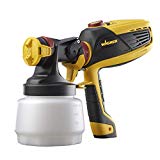
The best paint sprayer maker of low-end sprayers today is Wagner.
I consider this sprayer to be the only reliable choice that is not an airless paint sprayer:
- Very good reviews for this Wagner Flexio 590.
- No need to re-prime every time the siphon sucks air—nice
- Need to refill the reservoir frequently—not so nice
- Ideal for decks, fences, etc.
Honorable mention: HomeRight. A reader tells us she loves her 450-watt HomeRight. See it here: many good reviews and growing.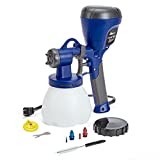 It’s low budget, so you will not get the same life out of it as the other on this page, but it may work for you. Clean it very well.
It’s low budget, so you will not get the same life out of it as the other on this page, but it may work for you. Clean it very well.
Low budget sprayer notes:
If you have only one project like interior paint spraying and you want to spray and then sell the machine (you only need it for a while), you can be sure the Wagner below will get you through.
- These cannot be used with a power roller extension: you need a separate unit for that or the sprayers just below. We explain power rollers in a post just for them.
- If you go low budget, you’ll eliminate a lot of painting hassles and save a lot of time, but you won’t have it for many years to come. For the money, they cannot go that distance.
2. The Graco Magnum: Best Medium-Budget Paint Sprayer
This online price is the best around for an excellent choice for DIY painting projects.
Tips and maintenance are made easy by this great sprayer company.
Maybe the best thing about airless sprayers is that the tip can be cleaned easily when clogged. Clogs are a natural part of spraying. How to minimize this is discussed below in the ‘how-to’.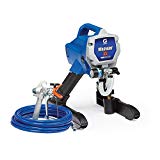
- The winner in the DIY airless race, from Graco: the Magnum X5 Stand Airless Paint Sprayer.
- Comes with RAC 4 latex tip and guard (“515” tip).
- On sale for at time of publication: they seem to always be “on-sale” if you know what I mean.
- Classified as a “DIY”, but used by many professionals (but check the high-budget below).
- Can be paired with Graco Pressure Roller Extension (buy the special roller covers on this page too). You’ll fly with this.
- I have a short post just on power rollers.
- Can be used with the Graco sprayer extension wand (it comes with the Rac4 Tip Guard). The extra paint spraying speed is well worth the cost. We use the 30″. Unlike the low-budget models, airless paint sprayer tips can be reversed and cleaned on the fly if clogged.
Watch a video of an airless sprayer getting cleaned quickly. I chose a Titan video because it is exactly the same as Graco or any other airless model. It’s all in your manual anyway. When he says ‘pump terps’ it means paint thinner (turpentine), blimey, mate.
Note: There are 2 versions of the Magnum 5: X and LTS. The LTS is sold only at Lowes so you get limited if you buy it there. But they are basically the same machine.
3. The King of DIY Airless Paint Sprayers: X7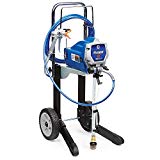
Many residential pros use this machine. It’s designed for those doing up to 12 new homes per year, so the quality is a step up. This means better reliability for only a little more price than the X5.
In the contractor chat rooms and in the paint stores, you’ll see that this is the most favored machine because of its longevity. For them, it pays for itself very quickly. Worth every dollar it costs.
Ample power for a 100 ft. hose to shoot ceilings and walls, interior, exterior…everything.
For all of you homeowners, this is my top recommendation in an airless paint sprayer.
You will get a great price online.
Enjoy. Lucky you.
Great Accessory: tip extension for an airless paint sprayer
The paint sprayer “wand” is a very helpful add-on. This page offers different lengths: my choice is the 30-inch wand, but you can have bigger or smaller. Size matters! 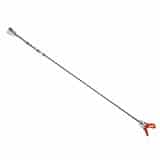
- Worth the small amount of extra cash for control and speed (and less ladder climbing)
- Excellent for both outdoor and indoor paint spraying
4. How to Use an Airless Paint Sprayer
You will find all the supplies I use on the paint sprayer accessories page
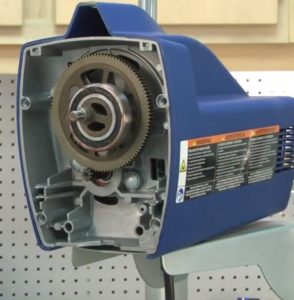
A quality paint sprayer is useless if not maintained properly: but it’s not hard.
You mostly just need to clean it well.
How to set up your paint spraying workspace:
- Pick a home base and clear the spraying area of anything that could get in your way: you’ll not be able to see obstacles and you could trip…and the hose can get stuck and hold you up (and tip over buckets).
- Protect everything! You can never have enough drop cloths. As a rule, I use old bedsheets from 2nd hand stores to cover furniture (sometimes doubled with a sheet of plastic) and keep the canvas on the floor. Always stir your paint well and then strain it to prevent clogs in the tip or at any internal filters. Clogging is the number-one complaint about spray-painting (see just below).
- Use a strainer bag for all paint, even new paint and keep the reservoir bucket covered with a clean piece of plastic: not an old drop cloth. We strain all paint, even right from the store (it can have small lumps from storage time). Strainers are on this page.
- Spend a fair amount of time masking everything in the area and covering cars outdoors. Indoors use plastic and green painter’s tape on this page (not the tan stuff) on windows. The best use of your time is to not try and make the masking perfect except around the odd piece of hardware. For example, to mask a window, use tape to cover some of the frame and all of the glass, then brush the frame later. It’s MUCH faster that way.
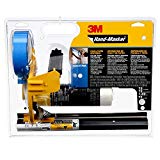
- This hand masker is your key tool. It rolls out tape connected to paper or plastic.
- Wear a respirator: HEPA for latex (really just for particles of paint), and chemical filters for oils. The ones I use are on the accessories page, but you can read all about the crazy, complicated world of respirators and filters: I simplified the best respirator here.
- I never really used spray suits but some painters do. My clothes were fine unless spraying oil-based stains or something nasty. If you get a spray suit, get 2 sizes too big and cuff the pants and arms: thank me later. The respirator is really the biggest necessity.
Spraying tips for beginners: how to use an airless paint sprayer
- Before starting the work, test the spray fan in a different area (or on some cardboard) to get the pattern that you want: always mask nearby items.
- Keep the paint sprayer fan perpendicular to the surface about 12″ away (don’t swing in an arc): this keeps the width or fan of the pass even and saves paint.
- Keep your pump pressure as low as possible and still be able to get a good spray pattern. This also reduces overspray and saves on tip life (and paint).
- On each pass, get the gun moving just before you pull the trigger. Paint in rows as long as possible before you start to arc away from perpendicular. A tip extension wand is great for this: a real money-maker (see above).
- While you are first learning, you will want to let off the trigger at the end of each stroke (before the gun stops moving). But as you get better, you’ll discover how to ‘flip your wrist’ at the end of a long stroke and jump to the next row in the opposite direction without stopping. Don’t rush that or your get drips and runs and sags at the end of the rows.
- Overlap passes of the fan slightly. If you don’t, the coverage will have gaps.
Why does my sprayer tip become clogged? Two reasons.
- You let the sprayer tip get dry when not in use: to prevent this, just rest the sprayer gun in a bucket of water/solvent.
- You need to strain every bit of paint, even new-right-from-the-store paint (this paint is already old and will have some coagulation.
Final tips on spraying paint with an airless paint sprayer
- Contours like door panels can leave ‘shadows’ if you don’t angle the gun to get the grooves evenly. Accomplish this by applying s
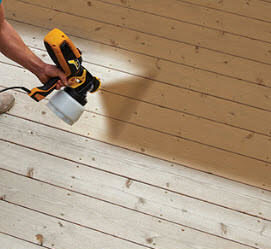 everal light coats from different directions, each perpendicular to one of the contoured pieces. In other words, hit anything that sticks out or is sunk in from both sides to prevent one side from being in the ‘shadow’.
everal light coats from different directions, each perpendicular to one of the contoured pieces. In other words, hit anything that sticks out or is sunk in from both sides to prevent one side from being in the ‘shadow’. - When doing primer, or the first of multiple coats, it’s best to ‘backroll’ the paint/primer after spraying for penetration and bonding. The topcoats can just be sprayed after that. Pros: let your customers know that you will do this: many painters will not and the paint job will not last as long (mostly for exteriors). Remember that paint sprayers are simply a method of application and are not known for great penetration. Still, they cut your time greatly.
- Ventilate well indoors, and be careful of wind outside (cars nearby could be damaged!)
List of supplies for painting with a sprayer:
(These are all on our accessories page)
- Respirator, safety glasses
- Fingerless gloves recommended (we cut the fingers off old work gloves)
- Solvent (water for latex, etc)
- At least 3 large buckets for paint, cleaning and trashy paint
- Strainer screens
- Rags and a small bucket for keeping rags wet
- Small bucket to keep spray gun tip soaking while not in use (prevents clogging)
- Drop cloths, plastic and tape, and hand masker (combines paper and tape—see our video below)
- Cardboard for use as a shield (you can buy a special cardboard holder – almost a necessity
See our recommended sprayer accessories
-
Tips on tips
These tips come from my experience of 30+ years as a professional painter. Basic tip chart is below: I only recommend Graco paint sprayer tips.
Basics for beginners:
- Every sprayer comes with a tip. Most Graco sprayers such as the Magnum x5 and the 210 ES ship with a “515” tip.
- How to read the tip model number: The first digit, 5, is half the fan width, so 10 inches. The ’15’ means the opening size which is a measure of volume that comes through. The 515 is a great medium volume tip and is part of the Graco RAC family (see below in Advanced Tips).
- Paint pressure near the spraying tip of the interior paint sprayer is enough to inject paint into your skin: be careful.
- Wear a respirator. The number of filters is mind-numbing. (My post simplifies the crazy complex world of respirator masks).
Advanced tips:
- Strain every gallon of paint, even right out of the can (prevents tip clogging).
- RAC tips (Reverse-a-Clean), are better even though they cost more, they save time. These tips can be reversed to clear clogs. When your fan pattern is showing ‘fingers’, you simply reverse the top, spray it into a bucket, and it’s clean. The RAC tips from Graco go in the orange tip guard (on the accessories page also). This tip guard and one RAC 4 (size 515 tip) come with both the Magnum and the 210ES above.
- Every time you stop for even a short break, soak the tip, and even the entire paint gun in a bucket (water for latex, thinner for oils, etc). This keeps the tip from clogging.
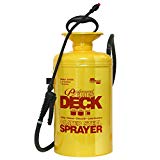 Finally, to make this post complete, we recommend a garden sprayer for spraying some stains – you can see it here: please understand what you can and cannot do with it. Read my research on how backpack sprayers not made for stains will die in a day. (Staining a deck? See one of my six articles on decks and staining).
Finally, to make this post complete, we recommend a garden sprayer for spraying some stains – you can see it here: please understand what you can and cannot do with it. Read my research on how backpack sprayers not made for stains will die in a day. (Staining a deck? See one of my six articles on decks and staining).The Chapin shown here can handle very light sealers and it does not cost much more than most good garden sprayers…but for heavy stains… you have to jump up in cost. Opaque stains (which are really just paint) require an airless paint sprayer. Read the backpack sprayer post.
Tip: Keep the paint sprayer tip (and hose) clean, disassemble, and let the hose dry all winter and it will last and still be useful in the garden for years! A bit of petroleum jelly on any gasket helps.
Chart: Recommended Tip Sizes for Common Coating Materials
| Lacquer or Stain | .009 – .013 |
| Oil Based Paint | .013 – .015 |
| Latex Paint | .015 – .019 (Magnum max size = .015) |
| Heavy Latex or Smooth Elastomeric | .021 – .025 |
| Elastomeric & Blockfiller | .025 – .035+ |
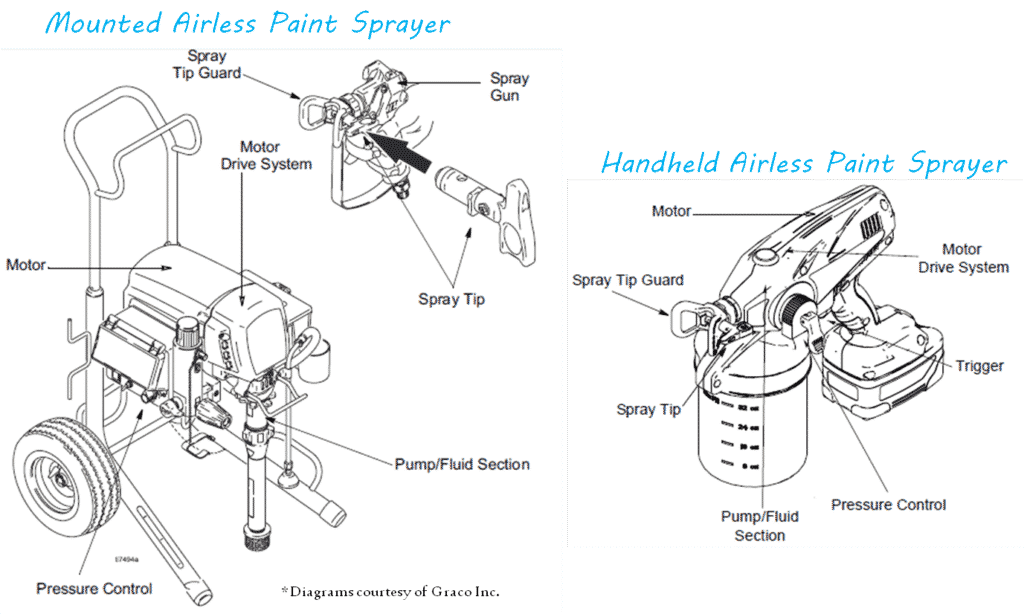
Here are some paint spraying tips from the maker: Graco website’s tip info chart.
Here is how to efficiently mask a window when spraying indoors or out.
If you will probably only use an interior paint sprayer once or twice, I recommend you spend your money on the low-budget electric paint sprayer: save money and save lots of time. Are the airless sprayers are better? Sure, but the electric paint sprayer will be enough (then you can sell it on eBay!)
Related: I have also written about very low-pressure HVLP sprayers, some of which can shoot latex. There is another type of airless as well, ‘handheld’ airless which uses a 1-liter cup and has about 2.3 the pressure of the ones below.
Let us know if we forgot anything in the comments below. Thanks.
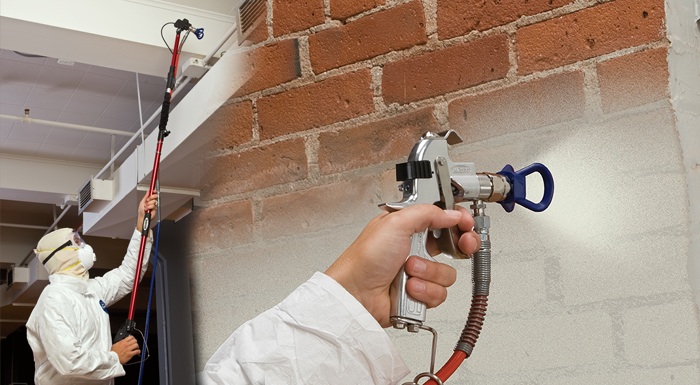

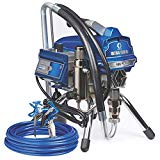
Thanks
Good job, cheers.
Hi – as always, thanks for the useful information. Slightly off topic, but I am planning to paint the exterior of my house. My mother-in-law thinks I’m crazy, and it’s not a doable DIY project. However, I have been using your guides for the trim and interior, and it turned out wonderfully so far. Anyway, I am planning to use one of the Graco sprayers you listed here but I have a question about the paint itself. We are painting wood siding from a dark brown to a cream color. The plan is to power wash the siding, scrape chipped paint, repair any damage/cracks to the wood, prime with oil primer then do 2 coats of the paint. Can a standard oil primer be used? I’ve been using BM Insl-x prime lock and Zinsser Coverstain primer and sealer, and it has worked well for priming interior wood trim.
Also, for the exterior paint, is there a difference between using the BM “ben waterborne exterior paint” vs the “regal select exterior”? We used regal select inside for everything, but the price is a consideration for the exterior since we will need so much paint.
Thanks again! All my DIY projects wouldn’t have been possible without your guides!
You have it all correct. Oil primer is best. MUST be exterior or int/ext.
The diff in price of the two paints you mentioned comes down to solids. More solids means more money means thicker means longer lasting.
My philosophy is price of paint is far less important than bleeping scraping cracked paint.
Get the best, extend the life so you can forget about it for as long as possible.
maybe even long enough for the Lions to win a SuperBowl.
b
Hi, I appreciate all your advice in the article as well as the comments. I am painting the exterior of my house 3 sides stucco and 1 side wood siding. I have had to do a lot of filling and sanding on the wood siding as well as scraping peeling paint. I am planning to use Zinsser Peel Stop primer on any of the peeling or filled and sanded areas and Behr Multi-Surface on the rest of the wood siding and stucco, will this be sufficient? I have already purchased a Graco Magnum Project Painter but am wondering if I should return it and get the Magnum x5 instead? I will also be using the sprayer on the interior at later date. My other question is regarding the best choice for exterior paint, since I am already priming the vast majority of the house is it overkill to use Behr Marquee paint? And if so can you recommend an alternative?
Thanks
All sounds good but remember that no liquid is going to replace scraping. Really take off all that wants to come off, feather the edges with a quick shot of maybe 80 grit or rougher…that goes fast. Then your primer.
I think there is a deal on the x5 via amaz now but not sure if it’s gone. see my ‘best sprayer’ for a link.
Behr. Mmm. It’s not BAD but its just that the big boys spend a lot more money in chemistry research and really punish the exterirors over years of testing. I like SW and Ben M. Really you get what you pay for in that world. My view is scraping sucks and painting sucks so get the best and paint less often..and spend less in the long run. And have more time to watch sports !
Good luck!
Thanks
Thanks
Hi Brad,
Thank you for your amazing advice and expertise. I’m about to paint all the interior walls and ceilings in my townhouse and your tips will be life savers. I’ve never sprayed before and want to buy a quality sprayer and I think I am leaning to buying the Graco Magnum X5. I’ve got about 1400 sq feet of wall space plus ceilings. Is this machine over kill for me in your opinion? I plan on painting the entire place once really and wouldn’t be doing any other big paint jobs. I would appreciate your insight! Many thanks
Hi. This machine would be the lowest-end machine I’d recommend. Any less expensive machine might konk out on you. Anyway, if you have only one big job, my opinion is to get a good machine, do the work, clean it well and put it on Facebook marketplace or Craigslist etc. Pros buy them for parts and backup.
So no, not overkill at all. In fact up from the Magnum line (which is aimed at homeowners) would get you better resale value. Pros don’t really use Magnum much…some do, however.
Good luck!
I have been researching airless paint sprayers for months. I really like Behr paint but it is so think (one of the reasons I love it) that I’m afraid it will clog all the time. Home Depot recommends a 60 mesh filter and a .015 to .019 tip. The max for the Magnum is .015. Is this going to work? Should I use a different paint?
I have 2 and 1/2 houses to paint all the interior walls and don’t want to use a roller – or waste my money on a sprayer that won’t work. Your advice is appreciated.
Very good question.
Personally, from experince the paint does not determine the tip. The tip is about the amount of paint and shape of the fan. I have never seen any difference in spraying latex from one company to another. Ben Moore Aura may be different as it’s so thick…anyway…
My philosopy on sprayers when you are doing that much is to get a pro model (magnum are aimed at homeowners who spray once in a while) and use it hard and re-sell.
You’ll get half your money at least and no problems but you won’t have a sprayer. Still, it’s a good plan.
Magnum will likely get you thru. I think those pumps need an overhaul every 600 gallons? No? I forget actually, but you should be ok, and then sell THAT and get your money back. If you ever need it again, do this all again. No storage to deal with and no problems. Just my opinion!
Wow, marvelous
Alternate between water based clear finish on cabinets, and latex on cabinets and the occasional casual furniture or small craft buildings. Think magnum would be best all around machine?
Well, yes and no, but the Magnum line would certainly be adequate. “Best’ would be a commercial machine, but for the homeowner, a sometimes spray painter, yes, I’d say it’s perfect.
Enjoy it!
This is a very helpful article. Amateurs in particular will be able to pick their best products after this article. Thank you so much for sharing such a beautiful article.
Hi Brad,
Your website is amazing. Thank you for taking the time with all of this.
I’m a former home builder that is finally finding some time to work on my own home. I have taken on the challenge of repainting my entire 2100 sq ft home myself. I redid all my base board, door casing, added window casing and stools to every window, crown molding almost everywhere, and am painting ceilings different color than walls.
Once I am done with painting my entire house, probably eventually exterior too (3 sides siding), I do plan on repainting investment homes once every 1-2 years. I also want to stain the fences with my airless sprayer (why I’m leaning for the 19 or 21 for the larger tip sizes).
Would I be good going with a magnum pro x19 or 21 for this first 5 years? I’m thinking I can eventually jump up to the pro series if I stick with this and use the magnum line for the first 5 years. Do you think the magnum 19/21 would last that 5 years based on the above?
Honestly, I’d avoid Magnum for pros, although some pros who do not spray much are happy with them.
I’d go with the 210ES or 390 if you have the extra money. Read about all the features that Magnums don’t have. It’s impressive.
They are made to pump a lot of gallons.
Just my opinion!
Then when you are done, you’ll get plenty of money back and will be out less than the cost of a Mag!
Great fun question (for me that is!)
B
Just picked up the 210ES! Somehow it dropped from $830 down to $680 yesterday on Home Depot!!! Thanks for you professional advising Brad!
Hi Brad,
Great site. I was reading your review on the X7. Any particular reason you like this better than the X19? I saw that one has a pump that can be changed out. I’m new to all this. So do these things die after the 12 houses you said in the review?
It all depends on what you will do with it. Price vs quality. The magnums have a bad name among contractors, but for home owners, it’s a good deal. They re-sale well too. If you are going to use it as a pro, don’t go magnum. Step up to a pro machine, which, by the way resell even better.
Also, sometimes the pump replacement is more than the machine.
Yes, they die young, but not the pro level machines. Even if you take good care, they parts are just not great which is why they can keep the price so low.
If I did not answer, please ask more on this page, and let me konw by email that you did. Sorry for the delays…just busy doing other things these days.
Good luck!
Brad
Hi,Thanks
Hey Brad….I’m getting a lot of info and advice from your site! Thanks for sharing your knowledge and experience.
I’m about to start a huge painting job (for me, anyway). I recently installed all new wood windows, which have a very detailed interior jamb profile, and replaced all the trim throughout my house. I’ll be painting with Benjamin Moore Advance in a custom off-white.
I’m kind of daunted by how time-consuming it is just to prep and prime and sand each window (beautiful windows, but again, LOTS of detail with divided lites and a complex jamb profile). I planned to brush two coats of finish, but man it’ll take forever!
It’s not practical to prep and mask all the windows in my house and then spray them all at once. Nor does it seem practical to do a room at a time and clean out a floor-standing pump after every session of primer and paint. (Working alone, a room at a time, there’ll be many such sessions.)
So now I’m wondering if one of those smaller handheld units might be a good option. I see Graco makes an whole line of them, and after watching a few videos, clean-up seems far more manageable for the many small paint sessions I’d be doing. Any thoughts on those sprayers? To be clear, this isn’t about saving money over a bigger unit….I’d spend an equivalent amount on a handheld if it’s the better fit for my project. I just want to know if you think it’d do a good job with BM Advance, and if you recommend any particular model. Thanks!
Well, first, congrats on your ambition. It’s not going to be brain surgery, but will take time and patience.
I think you are right not to think of masking all the glass and hardware and spray. Let me just tell you how a pro…well, this pro…
would approach such a job.
We’d come in sand all windows…sounds like yours are new so just a touch sand to knock off grit, then wipe with damp cloth and let dry.
Then prime all wood. If never primed, use an oil-based primer. For this we use a new brush and try to get a few days out of it. Oil is cruel to brushes, still, we’d spend 20 or more per brush because the speed of a Purdy is worth it: pays for itself.
Then since you’ll use Advance, change the 5-gallon set up, roller etc to latex, so all clean and dry grid, bucket and new Purdy “Nylox” brushes. One of those will last you this whole job. Read the post about cleaning brushes: it’s not hard but you must let it dry each night.
For quick rental work, we’d use an old Purdy but for detailed trim next to glass and wall, get a new one or two and you’ll see how it cuts the line by itself and your unsteady hand is compensated for. Other brushes I’ve tried…pro brushes… just don’t cut it. Ha ha. Pun but true.
Now, I roll and brush all my trim work, but you can spray: just get the 3M masker with tape, paper and plastic and seal off the glass and the wall around.
Best to have wall TU paint ready. touch up. sorry. Do all your t.u. at the end.
Then spray primer and 2 coats, then unmask, come back with brush and prime what was masked etc.
That would be faster, but the masking needs to be done carefully.
Yes, the handheld Graco is a good choice, but get a professional level machine. I’ll link to my fav below. Then you can keep or sell: they hold value.
The thing with lesser sprayers is that they are a one-hit-wonder. Great for a while, then they fail.
Graco not.
This graco can be used with any DeWalt 20V Li battery, so that folds into that system: nice.
If you might consider it…if I’ve been helpful… could you send me before and after pics? Would be great for others to see they can do it to and you’ll be inspired as you go to help others.
Just a thought.
PS, look at PrimeLock for your oil primer: stops most wood knots and will not raise grain, even in oak etc.
GOod luck!
B
Thanks for the great reply! I’ll describe where I’ve deviated from your approach as I’ve started the first 3-4 windows.
PRIMER: Trim is pre-primed WindsorONE and jambs are unfinished douglas fir…not “bleedy” like pine, but to be safe, I’ve been using BIN shellac-based. I like how well it seals, how fast it dries, and that it sands so nicely. I scuff & lightly prime the bare jambs -> sand -> spackle and caulk -> prime the whole assembly -> sand smooth. I’ve dedicated a good brush to this primer, and swish most material out into denatured alcohol and store in a small amount of same in a baggy, rather try to clean and dry it each time. That seems to work well and keeps it from getting crusty.
Question 1: You suggested oil primer. Do you think the BIN is a suitable alternative? Is there any drawback to it?
ADVANCE PAINT: Because there’s so much jamb detail and I’m not confident I can keep a wet edge to complete an entire mulled window assembly without gunking up somewhere, I taped off the outer “contiguous” part of the jamb & trim and just did the inner jamb detail first. Now I’ll remove the tape and do the rest. Two coats on each of these with each step a day apart, as Advance has a 16 hour re-coat. So you can see why it’s taking so long! haha It IS yielding nice results, though.
Question 2: You always roll & brush your trim work. To clarify, you think I should stick with my plan of brushing it rather than spraying? (The spraying idea was mostly about whether I’m crazy to do this whole project the “slow” way.)
Question 3: On flat trim, I can see how rolling gets the paint spread quickly, and then tipping off with the brush smooths it out. And I’ll do that on the flat areas of my trim. But when there are LOTS of little edges and inside corners, etc. on the jambs, I don’t quite see how that works. Advance runs easily and really has to be thin and even.
Would you still use a roller there, or just brush it all on?
BOTTOM LINE: Should I just keep doing what I’m doing? Tweak this process a bit? Or become a master masker and start spraying??
(I must’ve gotten spell-checked into “Patrick.” How sexist! haha It’s actually Patricia.)
Q1: certainly Bin is great. A bit of overkill, but no problem. I try to avoid it as it’s so volitile…but go with your feeling. PrimeLock would be my choice.
Don’t worry so much about the wet edge. You can sand between coats if you get some lines, but Advance is special in that it evens out. And it dries slowly.
Q2. Yes, I would say brush. The roller is just to go faster and not dip the brush so much which is slower and harder and messier.
Spraying is faster! But the masking … and the potential for overspray… and the sprayer is not free 🙂
Q3 Yes, for the small areas, a roller is no help. Just brush in sections defined by the cut of the wood. Right, you have to watch for runs. It’s alkyd, just like the old oils. They take time to dry and tend to run. Apply 2 light coats which is faster than struggling for one thick one. So in the end: Brush where you have to, roll where you can. I sound like a rock band.
Yes, keep doing what you are doing. Don’t rush. Good music helps. See if you can borrow a sprayer to see if you like it. Stay in touch.
B
Well, Brad, you gave me the confidence to blast ahead with roller and brush! And it’s looking great so far! I did the first finish coat on the big triple casement in the master bedroom. All in one session, no masking. I’m getting a feel for working with this paint…how much to load the roller, how heavy to apply it, how long I have to brush it out.
My biggest issue, actually, was that my Wooster mohair mini-roller started shedding a little, and I didn’t notice right away. So there’s a few of those critters to clean up before coat #2. Any mini-roller covers you recommend? (4-1/2″ x 1/4″ nap)
I’m still curious about those handheld Gracos….how cumbersome it’d be to use one in the house, and how the finish compares to brushing the Advance. Considering that I could use it on some small outdoor projects coming up this summer, I think I may get one and try it on at least one of the small windows. Perhaps just the final coat.
In any event….I’ll keep you posted! Thanks so much for your helpful advice!
Ah, rollers that shed. They usually come in the pan/brush/roller kits. Those are awful.
Try this one.
You can just pick the roller, no need to buy ‘frame’.
here at lowes
The Graco will be a nice smooth finish, but it’s got it’s own cost in more ways than one.
Just keep the wet tubes and tip clean and keep a pump fluid in it when in storage.
Rock on.
Hi Brad,
I am a Correctional Officer and not a professional painter but been doing a lot of painting at my home. I noticed in one of your videos you stated you spray paint your trim. Any particular spray painters you recommend? Thank you.
Hi. I thought you were tacking me down after my big escape! Ha ha. The answer to your question really depends on how much you have to do, and what your future plans are. Yes, we spray in some cases, but of course you can imagaine the overspray on walls and so on.
The few cases where this would work are mostly in new construction and renovations.
If the carpenters have the trim up, and we come in, we’ll spray the primer on the trim, spray the primer on the walls, then spray 2 coats of the top-coat on the trim and the trim is done just like that. Needless to say, we mask the glass and hardware first. If painting doors, we remove all the hardware…etc.
Then we mask the trim with tape and paper or tape and plastic (see my main tools page for the 3M masker: big time saver). Then we spray ceilings and walls. Then we unveil all masking and touch up the edges.
For this we’d use an airless like you see on this page above. Since you don’t work professioanlly, try the Magnum if you go this way.
If you are just re-doing the trim in a few rooms, and you will also do walls etc, this may work too.
For this, go with the Wagner Flexio also on this page. I’ll be adding a slightly more expensive, but better small sparyer (called HVLP) soon. Graco is the best brand and they make this model, which uses the normal airless type tips, so you have to learn about all that. For small quickies, the Wagner may be better. Main point: clean it well and don’t let paint dry at the tip.
If you are just doing trim and nothing else, get the roller/brush combo I talk about in this post. Roll the paint to distribute, then ‘tip it out’ with the brush. You never need to dip your brush in the bucket as a rule.
It’s fast.
Brushing alone is fairly slow.
You could just brush if you have no inmates to track down!
Good luck!
Here is the tools page. Let me know by reply here if you have any more quesitons but the linked post above should cover it all.
b
Hi Brad- I paint furniture for the most part. Lately we’ve been using a fair amount of ppg breakthrough Paint which magically combines the best of oil and water based paints. We also use a fair amount of chalk paint. What sprayer would you recommend assuming we are painting at most one or two pieces a week?
Hi. For small projects, a small sprayer. If you think you might do big jobs like rooms in a house, go airless, but otherwise, the low pressure sprayers work fine. Just keep them clean. The Wagner Spraytech is certainly good, but for really just a few more bucks, the Graco TrueCoat 360 you see here is far better. Same thing, keep it clean and when taking a break, keep the tip wet as I discussed in the post above. Thanks for writing!
b
Hi Brad,
I’m going to be spraying our basement drop ceiling tiles. They are showing some very mild yellowing, but noting too major as far as staining goes. What would you recommend? I wasn’t sure how much paint the tiles would absorb or if I should prime first. Great website! Thanks for any advice.
Hi. Yes the first coat will absorb quite a lot. If it has a texture, shoot each tile lighly from 4 different angles…or whatever you can do…to get it in the cracks
The yellowing is just age right? not water damage? If just age, since you will need multiple coats…probably just 2… use a medium powered stain blocking primer first. this should stop the yellow from coming thru the final coat. I’m assuming you’ll spray white. This Kilz product is water-based so if you will spray water-based paint later, you can switch to the paint without cleaning. If you want to spray oil…why would anyone ever?… use an oil primer to avoid cleaning between coats. Make sense?
Good luck
b
I’d probably remove tiles and lean against a wall covered with plastic or a wall you’ll paint later. Spraying down is so much easier and you need 2 coats. Also the tiles won’t stick later when you need to remove one or 2.
Are you still available to paint interiors? I have an interesting project in Stratford.
Sorry I don’t live near you! Look for an older painter..younger ones make mistakes… I know!
Hello, great article and appreciate the insight. I have various painting and sealing projects in the short term prior to moving into a house. I really want a sprayer to make it less work but am divided on the low budget or mid budget sprayer which one would be better. I need to paint various rooms and also reseal some wood cabinets. I may use it again in the future but unsure which way to go. Is either one better as an “all around” sprayer for both sealers (varnish and similar) and paint (interior and maybe exterior projects).
Hi. No doubt you would want the airless. The Graco Magnum is the one priced for homeowners.. the other one is great, but built to really work day-in and day-out for years… Price reflects that. You can spray all that you listed: just do some practice and gather all the buckets, solvents and rags, not to mention masker/tape/plastic, drop cloths.
For the amount of work you plan to do, the small budget (Wagner) will just fustrate you. It can spray a quart at a time, then you re-fill. A medium sized bedroom needs about 3/4 gallon per coat…just for walls. Go Graco is my view. The re-sale value will get you 1/2 of what you paid especially if it’s only a few months old…So you will be laughing. Good luck!
I read that airless is less desirable than HVLP for interior walls because the paint doesn’t go on as smoothly due to the higher pressure. Do you agree? I’ve never used a sprayer before, but plan to paint all the walls in our house so I think it is a worthwhile investment.
Yes, it is certainly worthwhile: and when done you can get most of your money back on ebay or local ad sale. The airless machines do have a pressure control knob, but there is a minimum. As you wrote, the HVLP has the ‘low pressure’ right in the name, LP (HV is high volume for other readers)… We think of them as more for furniture…like a spray can that you refill. From memory, the airless goes on just as smooth, but you are working with latex on walls usually, so your goal is not the same as furniture painting etc. Good luck!!